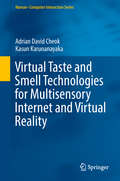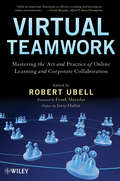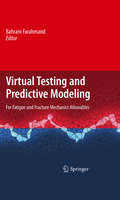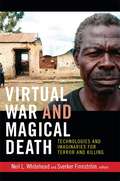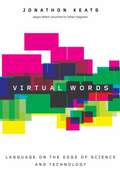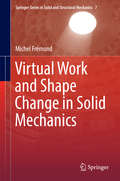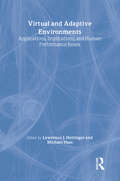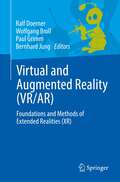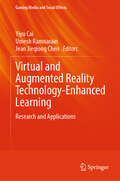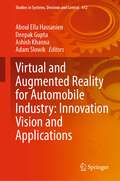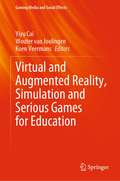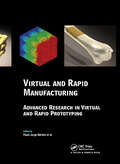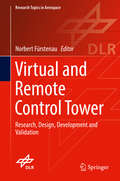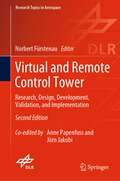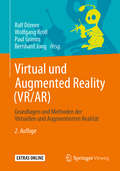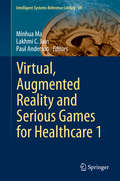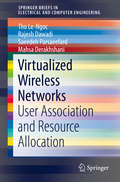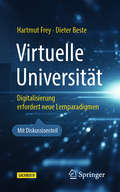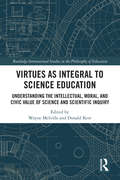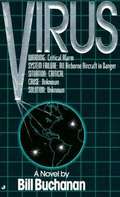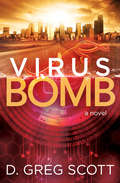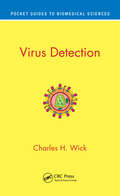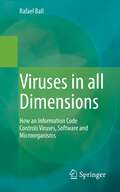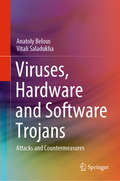- Table View
- List View
Virtual Taste and Smell Technologies for Multisensory Internet and Virtual Reality
by Adrian David Cheok Kasun KarunanayakaCurrently, Internet and virtual reality communication is essentially audio-visual. The next important breakthrough of the Internet will be the communication and sharing of smell and taste experiences digitally. Audio-visual stimuli are frequency based, and they can be easily digitized and actuated. On the other hand, taste and smell stimuli are based on chemical molecules, therefore, they are not easy to digitize or actuate. To solve this problem, we are required to discover new digital actuation technologies for taste and smell. The authors of this book have experimented on developing digital actuation devices for several years. This book will provide a complete overview of the importance of digitizing taste and smell, prior works, proposed technologies by the authors, other state of the art research, advantages and limitations of the proposed methods, and future applications. We expect digital taste and smell technologies will revolutionize the field of multisensory augmented reality and open up new interaction possibilities in different disciplines such as Human Computer Interaction, Communication, and Augmented and Virtual Reality.
Virtual Teamwork: Mastering the Art and Practice of Online Learning and Corporate Collaboration
by Jerry Hultin"This book, by Robert Ubell and his excellent team of collaborators, adds an important dimension to effective teaching and learning in online environments. It addresses how interaction and collaboration online can be effectively harnessed in virtual teams. It is an important contribution to the larger field of Internet-based education." —Frank Mayadas, Alfred P. Sloan Foundation How to create and manage highly successful teams online With the advent of the global economy and high-speed Internet, online collaboration is fast becoming the norm in education and industry. This book takes online collaboration to the next level, showing how you can bolster online learning and business performance with the innovative use of virtual teams. Written by a team of experts headed by online learning pioneer Robert Ubell, Virtual Teamwork covers best practices for online instruction and team learning, reveals proven techniques for managing enterprise and global virtual teams, and helps you choose the best communication tools for the job. Educators, project managers, and anyone involved in teaching online courses or creating online programs will find a wealth of tips and techniques for building and managing successful virtual teams, including guidance for: Integrating team instruction in the virtual classroom Using best techniques for team interaction across borders and time zones Structuring cost-effective, competitive projects that work Leveraging leadership, mentoring, and conflict management in virtual teams Conducting testing, grading, and peer- and self-assessment online Managing corporate, global, and engineering virtual teams Choosing the right technologies for effective collaboration
Virtual Testing and Predictive Modeling
by Bahram FarahmandVirtual Testing and Predictive Modeling: Fatigue and Fracture Mechanics Allowables provides an overview of cost and time efficient methods in measuring the quality of industrial structural parts. Readers will find a systematic introduction to virtual testing to generate fatigue and fracture allowables through two useful techniques: the conventional continuum mechanics approach, and the utilization of multiscale modeling and simulation techniques to predict materials' properties. A chapter devoted to the functionalization process covers the current approach to this technique, which strengthens interface durability through bonding dissimilar materials. Coverage of verification methods, used with devices such as the Transmission Electron Microscope (TEM) and the Atomic Force Microscope (AFM), are also described, which motivate discussion of the fundamental structure and deformation processes of nanoscale materials. The virtual testing continuum approach already plays a crucial role in the life assessment of important manufactured structural parts in the aerospace, automotive, aircraft and defense industries. Virtual Testing and Predictive Modeling: Fatigue and Fracture Mechanics Allowables provides a unique applications-focus view into these valuable methods, filling a critical void in references currently available.
Virtual War and Magical Death: Technologies and Imaginaries for Terror and Killing
by Neil L. Whitehead Sverker FinnströmVirtual War and Magical Death is a provocative examination of the relations between anthropology and contemporary global war. Several arguments unite the collected essays, which are based on ethnographic research in varied locations, including Guatemala, Uganda, and Tanzania, as well as Afghanistan, Pakistan, Iraq, and the United States. Foremost is the contention that modern high-tech warfare--as it is practiced and represented by the military, the media, and civilians--is analogous to rituals of magic and sorcery. Technologies of "virtual warfare," such as high-altitude bombing, remote drone attacks, night-vision goggles, and even music videoes and computer games that simulate battle, reproduce the imaginative worlds and subjective experiences of witchcraft, magic, and assault sorcery long studied by cultural anthropologists. <P><P> Another significant focus of the collection is the U. S. military's exploitation of ethnographic research, particularly through its controversial Human Terrain Systems (HTS) Program, which embeds anthropologists as cultural experts in military units. Several pieces address the ethical dilemmas that HTS and other counterinsurgency projects pose for anthropologists. Other essays reveal the relatively small scale of those programs in relation to the military's broader use of, and ambitions for, social scientific data.
Virtual Words: Language on the Edge of Science and Technology
by Jonathon KeatsThe technological realm provides an unusually active laboratory not only for new ideas and products but also for the remarkable linguistic innovations that accompany and describe them. How else would words like qubit(a unit of quantum information), crowdsourcing (outsourcing to the masses), orin vitro meat (chicken and beef grown in an industrial vat) enter our language? In Virtual Words: Language on the Edge of Science and Technology, Jonathon Keats, author of Wired Magazine's monthly Jargon Watch column, investigates the interplay between words and ideas in our fast-paced tech-driven use-it-or-lose-it society. In 28 illuminating short essays, Keats examines how such words get coined, what relationship they have to their subject matter, and why some, like blog, succeed while others, like flog, fail. Divided into broad categories--such as commentary, promotion, and slang, in addition to scientific and technological neologisms--chapters each consider one exemplary word, its definition, origin, context, and significance. Examples range from microbiome(the collective genome of all microbes hosted by the human body) and unparticle(a form of matter lacking definite mass) to gene foundry (a laboratory where artificial life forms are assembled) and singularity (a hypothetical future moment when technology transforms the whole universe into a sentient supercomputer). Together these words provide not only a survey of technological invention and its consequences, but also a fascinating glimpse of novel language as it comes into being. No one knows this emerging lexical terrain better than Jonathon Keats. In writing that is as inventive and engaging as the language it describes, Virtual Words offers endless delights for word-lovers, technophiles, and anyone intrigued by the essential human obsession with naming.
Virtual Work and Shape Change in Solid Mechanics
by Michel FrémondThis book provides novel insights into two fundamental subjects in solid mechanics: virtual work and shape change. The author explains how the principle of virtual work represents a tool for analysis of the mechanical effects of the evolution of the shape of a system, how it can be applied to observations and experiments, and how it may be adapted to produce predictive theories of numerous phenomena. The book is divided into three parts. The first relates the principle of virtual work to what we observe with our eyes, the second demonstrates its flexibility on the basis of many examples, and the third applies the principle to predict the motion of solids with large deformations. Examples of both usual and unusual shape changes are presented, and equations of motion, some of which are entirely new, are derived for smooth and non-smooth motions associated with, for instance, systems of disks, systems of balls, classical and non-classical small deformation theories, systems involving volume and surface damage, systems with interactions at a distance (e. g. , solids reinforced by fibers), systems involving porosity, collisions, and fracturing of solids.
Virtual and Adaptive Environments: Applications, Implications, and Human Performance Issues
by Michael Haas Lawrence J. HettingerWith contributions from a collection of authors consisting of many recognizable experts in the field of virtual and adaptive environments, as well as many up and coming young researchers, this book illustrates the many ways in which psychological science contributes to and benefits from the increased development and application of these nascent systems. Discussing issues from both a user- and technology-based standpoint, the volume examins the use of human perception, cognition, and behavior. The book builds a foundation on the assumption that these systems are first and foremost human-centered technologies, in that their purpose is to complement and extend human capabilities across a wide variety of domains.
Virtual and Augmented Reality (VR/AR): Foundations and Methods of Extended Realities (XR)
by Wolfgang Broll Paul Grimm Bernhard Jung Ralf DoernerThis comprehensive textbook offers a scientifically sound and at the same time practical introduction to Virtual and Augmented Reality (VR/AR). Readers will gain the theoretical foundation needed to design, implement or enhance VR/AR systems, evaluate and improve user interfaces and applications using VR/AR methods, assess and enrich user experiences, and develop a deeper understanding of how to apply VR/AR techniques. Whether utilizing the book for a principal course of study or reference reading, students of computer science, education, media, natural sciences, engineering and other subject areas can benefit from its in-depth content and vivid explanation. The modular structure allows selective sequencing of topics to the requirements of each teaching unit and provides an easy-to-use format from which to choose specific themes for individual self-study. Instructors are provided with extensive materials for creating courses as well as a foundational text upon which to build their advanced topics. The book enables users from both research and industry to deal with the subject in detail so they can properly assess the extent and benefits of VR/AR deployment and determine required resources. Technology enthusiasts and professionals can learn about the current status quo in the field of VR/AR and interested newcomers can gain insight into this fascinating world. Grounded on a solid scientific foundation, this textbook, addresses topics such as perceptual aspects of VR/AR, input and output devices including tracking, interactions in virtual worlds, real-time aspects of VR/AR systems and the authoring of VR/AR applications in addition to providing a broad collection of case studies.
Virtual and Augmented Reality Technology-Enhanced Learning: Research and Applications (Gaming Media and Social Effects)
by Yiyu Cai Umesh Ramnarain Jean Jieqiong ChenThis book consists of chapters that present the state-of-the-art research and applications of Virtual & Augmented Reality Technology-enhanced Learning (VARTeL). The chapters of the book present a multi-facet view on different approaches to deal with challenges that surround the uptake of educational applications of mixed reality, simulations, and serious games in various practices. The different approaches highlight challenges and potential solutions and provide future directions for mixed reality, simulation, and serious games research, for the design of learning material and for implementation. By doing so, the book is a useful resource for both students and scholars interested in research in this field, for designers of learning material, and for practitioners that want to embrace mixed reality, simulation, and/or serious games in their education.
Virtual and Augmented Reality for Automobile Industry: Innovation Vision and Applications (Studies in Systems, Decision and Control #412)
by Aboul Ella Hassanien Deepak Gupta Ashish Khanna Adam SlowikThis book presents the augmented reality (AR) and virtual reality (VR) automotive applications. It unites automobile with a leading technology i.e. augmented and virtual reality and uses the advantages of the latter to solve the problems faced by the former. The book highlights the reasons for the growing abundance and complexity in this sector. Virtual and augmented reality presents a powerful engineering tool that finds application in various engineering fields. It brings new possibilities that result is increasing of productivity and reliability of production, quality of products and processes. The book further illustrates the possible challenges in its applications and suggests ways to overcome them. The book includes nine chapters focusing on automobile collision avoidance, self-driving cars, autonomous vehicles, navigation systems, and many more applications.
Virtual and Augmented Reality, Simulation and Serious Games for Education (Gaming Media and Social Effects)
by Yiyu Cai Wouter Van Joolingen Koen VeermansThis book introduces state-of-the-art research on virtual reality, simulation and serious games for education and its chapters presented the best papers from the 4th Asia-Europe Symposium on Simulation and Serious Games (4th AESSSG) held in Turku, Finland, December 2018. The chapters of the book present a multi-facet view on different approaches to deal with challenges that surround the uptake of educational applications of virtual reality, simulations and serious games in school practices. The different approaches highlight challenges and potential solutions and provide future directions for virtual reality, simulation and serious games research, for the design of learning material and for implementation in classrooms. By doing so, the book is a useful resource for both students and scholars interested in research in this field, for designers of learning material, and for practitioners that want to embrace virtual reality, simulation and/or serious games in their education.
Virtual and Rapid Manufacturing: Advanced Research in Virtual and Rapid Prototyping
by Ljubomir TanchevCollection of 120 peer-reviewed papers that were presented at the 3rd International Conference on Advanced Research in Virtual and Rapid Prototyping, held in Leiria, Portugal in September 2007. Essential reading for all those working on V&RP, focused on inducing increased collaboration between industry and academia. In addition to key
Virtual and Remote Control Tower
by Norbert FürstenauThe interdisciplinary research and development work carried out in the last ten years which is presented in this book aimed at replacing the conventional airport control tower by a new "remote tower operation" work environment (RTO) which should enhance work efficiency and safety and reduce costs. This revolutionary human-system interface allows for remote aerodrome traffic control without a physical tower building and enables the establishment of remote airport traffic control centers (RTC) of which each may serve several airports from a central location.
Virtual and Remote Control Tower: Research, Design, Development, Validation, and Implementation (Research Topics in Aerospace)
by Norbert FürstenauThis book presents the interdisciplinary and international “Virtual and Remote Tower” research and development work. It has been carried out since nearly twenty years with the goal of replacing the conventional aerodrome control tower by a new “Remote Tower Operation” (RTO) work environment for enhancing work efficiency and safety and reducing cost. The revolutionary human–system interface replaces the out-of-windows view by an augmented vision video panorama that allows for remote aerodrome traffic control without a physical tower building. It enables the establishment of a (multiple) remote control center (MRTO, RTC) that may serve several airports from a central location. The first (2016) edition of this book covered all aspects from preconditions over basic research and prototype development to initial validation experiments with field testing. Co-edited and -authored by DLR RTO-team members Dr. Anne Papenfuss and Jörn Jakobi, this second extended edition with nearly doubled number of chapters includes further important aspects of the international follow-up work towards the RTO-deployment. Focus of the extension with new contributions from ENRI/Japan and IAA/Dublin with Cranfield University, is on MRTO, workload, implementation, and standardization. Specifically, the two revised and nine new Chapters put the focus on inclusion of augmented vision and virtual reality technologies, human-in-the-loop simulation for quantifying workload and deriving minimum (technical) requirements according to standards of the European Organization for Civil Aviation Equipment (EUROCAE), and MRTO implementation and certification. Basics of optical / video design, workload measures, and advanced psychophysical data analysis are presented in four appendices.
Virtual und Augmented Reality: Grundlagen und Methoden der Virtuellen und Augmentierten Realität (Examen. Press Ser.)
by Ralf Dörner Wolfgang Broll Paul Grimm Bernhard JungLernen Sie mit diesem Buch die Grundlagen der Virtuellen und Augmentierten Realität kennen Dieses Buch über die Virtuelle und Augmentierte Realität ist sowohl für Praktiker und Interessierte im Selbststudium als auch für Studierende geeignet. Letztere können es hervorragend als Begleitlektüre für entsprechende Lehrveranstaltungen, zum Beispiel in der Informatik nutzen. Die zweite Auflage wurde umfassend erneuert und erweitert. Mit ihrer Hilfe kann der Leser sein Verständnis für das Themengebiet rund um die VR und AR vertiefen. Thematisch schneidet das Buch viele Bereiche der Virtuellen und Augmentierten Realität an, darunter beispielsweise Wahrnehmungsaspekte der AR, Interaktionen in einer virtuellen Welt oder die mathematischen Basics für VR und AR. (105)
Virtual und Augmented Reality: Grundlagen und Methoden der Virtuellen und Augmentierten Realität (eXamen.press)
by Ralf Dörner, Wolfgang Broll, Paul Grimm and Bernhard JungDas Lehrbuch vermittelt die theoretischen und praktischen Grundlagen, die benötigt werden, um Virtual- und Augmented-Reality-Systeme (VR/AR) eigenständig zu realisieren oder zu erweitern. Es dient Studierenden als anschauliche Begleitlektüre zu Lehrveranstaltungen, die VR/AR thematisieren, u. a. in den Fächern Informatik, Medien oder Natur- und Ingenieurwissenschaften. Durch seinen modularen Aufbau eignet sich der Band auch für das Selbststudium und kann darüber hinaus als Nachschlagewerk verwendet werden.
Virtual, Augmented Reality and Serious Games for Healthcare 1
by Paul Anderson Lakhmi C. Jain Minhua MaThere is a tremendous interest among researchers for the development of virtual, augmented reality and games technologies due to their widespread applications in medicine and healthcare. To date the major applications of these technologies include medical simulation, telemedicine, medical and healthcare training, pain control, visualisation aid for surgery, rehabilitation in cases such as stroke, phobia and trauma therapies. Many recent studies have identified the benefits of using Virtual Reality, Augmented Reality or serious games in a variety of medical applications. This research volume on Virtual, Augmented Reality and Serious Games for Healthcare 1 offers an insightful introduction to the theories, development and applications of virtual, augmented reality and digital games technologies in medical and clinical settings and healthcare in general. It is divided into six sections: section one presents a selection of applications in medical education and healthcare management; Section two relates to the nursing training, health literacy and healthy behaviour; Section three presents the applications of Virtual Reality in neuropsychology; Section four includes a number of applications in motor rehabilitation; Section five aimed at therapeutic games for various diseases; and the final section presents the applications of Virtual Reality in healing and restoration. This book is directed to the healthcare professionals, scientists, researchers, professors and the students who wish to explore the applications of virtual, augmented reality and serious games in healthcare further.
Virtualized Wireless Networks
by Tho Le-Ngoc Mahsa Derakhshani Saeedeh Parsaeefard Rajesh DawadiThere have been recent advancements in wireless network technologies such as wireless virtualization to accommodate the exponential growth in demand, as well as to increase energy and infrastructure efficiencies. This SpringerBrief discusses the user-association and resource-allocation aspects in Virtualized Wireless Networks (VWNs) and highlights key technology innovations to meet their requirements. Various issues in practical implementation of VWNs are discussed along with potential techniques such as Massive MIMO, Cloud-Radio Access Network (C-RAN), and non-orthogonal multiple access (NOMA). This SpringerBrief will target researchers and professionals working on current and next-generation wireless networks. The content is also valuable for advanced-level students interested in wireless communications and signal processing for communications.
Virtuelle Universität: Digitalisierung erfordert neue Lernparadigmen (Technik im Fokus)
by Dieter Beste Hartmut FreyDas Buch vermittelt das Konzept einer globalen, virtuellen Universität in Kombination mit neuen Erkenntnissen aus der Lernforschung. Hierbei werden mithilfe von künstlicher Intelligenz bewegungsorientierte, virtuelle 3-D-Bilder eingebunden. Dadurch wird die Lernbereitschaft und damit auch die Kreativität des Einzelnen angeregt. So werden bereits heute Schweißer in Großunternehmen mittels Datenbrille und intelligenter Avatare ausgebildet. Über eine virtuelle Universität lassen sich Forschungsprojekte initiieren und koordinieren. Problemlösungen lassen sich mit der Verwendung von Avataren in virtuellen Hörsälen erarbeiten. Die Zertifizierung erfolgt nicht mehr über das Abfragen von Wissensinhalten, sondern über die Fähigkeit Probleme zu lösen. Weitere wichtige Aspekte einer virtuellen Universität sind, im Vergleich zu den klassischen Universitäten, die geringen Kosten, die Möglichkeit bei der Entwicklung des Contents die besten Wissenschaftler zu beteiligen sowie die immer mehr um sich greifende Sekundär- und Tertiärforschung. Eine virtuelle Universität bietet die Chance der Emanzipation gesellschaftlicher Praxis von Wissenschaft durch Wissenschaft und Immunisierung gesellschaftlich geltende Ideologien und Interessenstandpunkte gegen wissenschaftliche Aufklärungsansprüche.
Virtues as Integral to Science Education: Understanding the Intellectual, Moral, and Civic Value of Science and Scientific Inquiry (Routledge International Studies in the Philosophy of Education)
by Wayne Melville; Donald KerrBy investigating the re-emergence of intellectual, moral, and civic virtues in the practice and teaching of science, this text challenges the increasing professionalization of science; questions the view of scientific knowledge as objective; and highlights the relationship between democracy and science. Written by a range of experts in science, the history of science, education and philosophy, the text establishes the historical relationship between natural philosophy and the Aristotelian virtues before moving to the challenges that the relationship faces, with the emergence, and increasing hegemony, brought about by the professionalization of science. Exploring how virtues relate to citizenship, technology, and politics, the chapters in this work illustrate the ways in which virtues are integral to understanding the values and limitations of science, and its role in informing democratic engagement. The text also demonstrates how the guiding virtues of scientific inquiry can be communicated in the classroom to the benefit of both individuals and wider societies. Scholars in the fields of Philosophy of Science, Ethics and Philosophy of Education, as well as Science Education, will find this book to be highly useful.
Virus Bomb: A Novel
by D. Greg ScottAn IT contractor stumbles upon a massive terror plot—and must come out from behind his keyboard to stop it. Jerry Barkley has never worked for the government. An IT contractor from Minnesota, he knows nothing about international espionage. But now he&’s on the front lines of the largest cyberattack in history—and nobody believes his warnings that an enemy is gathering data to plan a series of bombings and an act of biological warfare. To make things worse, the FBI suspects he&’s the attacker. Hundreds have already died in bombings and thousands more could be next—first from Ebola and then, potentially, from war with the wrong enemy. Facing willful ignorance and a hostile law-enforcement bureaucracy, Jerry is forced to take action. He has no choice but to leave his comfort zone, armed with nothing but his tech skills and his quick wits, and go face-to-face with elite foreign agents to shut the attack down.
Virus Detection (Pocket Guides to Biomedical Sciences)
by Charles H. WickViruses do not behave as other microbes; their life cycles require infecting healthy cells, commandeering their cellular apparatus, replicating and then killing the host cell. Methods for virus detection and identification have been developed only in the past few decades. These recently developed methods include molecular, physical, and proteomic techniques. All these approaches (Electron Microscopy, Molecular, Direct Counting, and Mass Spectrometry Proteomics) to detection and identification are reviewed in this succinct volume. It is written in approachable language with enough detail for trained professionals to follow and want to recommend to others. Key Features Covers common detection methods Reviews the history of detection from antiquity to the present Documents the strengths and weaknesses of various detection methods Describes how to detect newly discovered viruses Recommends specific applications for clinical, hospital, environmental, and public health uses
Viruses in all Dimensions: How an Information Code Controls Viruses, Software and Microorganisms
by Rafael BallMicroorganisms, viruses, and computer programs encode all the information necessary to reproduce and spread themselves. Yet these mechanisms are amazingly similar in the animate world, in the world of viruses, and even in the world of technical systems. The book shows how great the parallels are between these various animate and inanimate replicating systems and what they are based on.The excursion also leads into the fascinating world of genetics, to the question of what defines life and into the programming of software that multiplies itself independently. Finally, the question is derived whether and to what extent such self-replicating technical systems can become as dangerous as infectious viruses in triggering pandemics, such as the Corona pandemic in 2020.
Viruses, Hardware and Software Trojans: Attacks and Countermeasures
by Anatoly Belous Vitali SaladukhaThis book provides readers with a valuable reference on cyber weapons and, in particular, viruses, software and hardware Trojans. The authors discuss in detail the most dangerous computer viruses, software Trojans and spyware, models of computer Trojans affecting computers, methods of implementation and mechanisms of their interaction with an attacker — a hacker, an intruder or an intelligence agent. Coverage includes Trojans in electronic equipment such as telecommunication systems, computers, mobile communication systems, cars and even consumer electronics. The evolutionary path of development of hardware Trojans from "cabinets", "crates" and "boxes" to the microcircuits (IC) is also discussed. Readers will benefit from the detailed review of the major known types of hardware Trojans in chips, principles of their design, mechanisms of their functioning, methods of their introduction, means of camouflaging and detecting, as well as methods of protection and counteraction.
